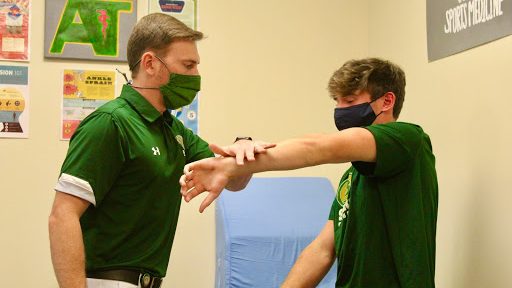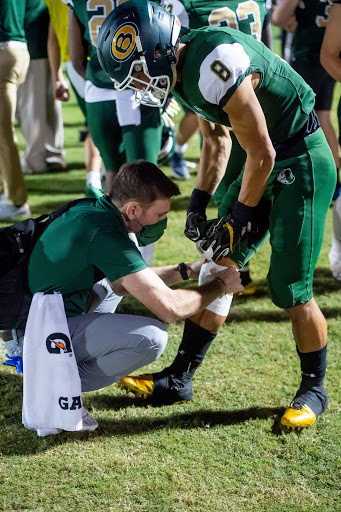
Briarcrest Christian athletic trainer Marquis experiencing COVID-19 changes firsthand
EADS, Tenn. (BVM) — Athletic trainer Logan Marquis, 26, has seen a lot of things over his years working on the sidelines of sports. From being a graduate assistant working for D1 Troy University to working the past three years as head athletic trainer for Briarcrest Christian High School, Marquis has been to hundreds of practices, games and other athletic performances. However, as has been the case for any athletics staff member, COVID-19 has provided a different type of battle for Marquis.
It all began for Marquis in early March when the pandemic was first getting underway. While Shelby County moved quickly to shut down events and activities to prevent further spreading of the virus, Marquis found himself in a perilous position.
“At the beginning, a lot of worries were floating around obviously,” Marquis said. “(We were) not really knowing what to anticipate with how the school year was going to go and we ended up shutting down in the spring.”
While his athletic training duties were eliminated for the time being, Marquis returned to Campbell Clinic Orthopaedics, the medical group that works in partnership with Briarcrest schools to provide care. Unlike many of his other athletic training colleagues who had been laid off or furloughed during the pandemic, Marquis was still able to work in the medical field doing inpatient screenings for the clinic while he awaited news from the state on a possible return to sports. As to be expected, the days as a COVID-19 screener had both its good and bad moments.
“I was very thankful we had that opportunity to come back and work outside of the school because of athletic trainers I knew didn’t have that luxury,” Marquis said. “(Working) was good in the sense that I got to go back to the clinic and work with coworkers I don’t see very often so that was nice. … It was tough sometimes dealing with patients that came in. … You had your run-ins with certain patients that took it out on you being the first one they see when they come through the door.”
When the Tennessee Secondary School Athletic Association finally gave word that the individual counties could make a decision to play sports based on the advice of their local health department, Marquis saw a glimmer of hope. Shortly after that news around mid-July, Shelby County Health Department announced it would allow athletics to begin shortly, so after five months, Marquis was able to return to Briarcrest.
“It was kind of spur of the moment,” Marquis said. “It was a very happy moment, but still a lot of uncertainty of how long it was going to be that way and if we would be able to go back out and stay at our school. … It was still a very unsure feeling, but I was happy to be back out at my high school because that’s what I love to do.”
However, when he got back, the sports weren’t the ones he was used to watching when he was an athletic trainer. Due to the increased protocols and procedures to prevent outbreaks at schools, teams were forced to socially distance, work in small groups and wear masks, much different than anything Marquis had seen before in sports.
“Sports really didn’t look like sports anymore,” Marquis said. “We had to implement so many guidelines as far as social distancing and working in small groups and the amount of face-to-face communication between the coaches and athletes. (It) looked completely different as well as my role as an athletic trainer which is a very hands-on job. That was tough to work back into.”
There were some headaches early. Many kids, with their summers limited to only what quarantine would allow, were slow to adhere to the initial changes in sports, wanting to be close to friends and teammates they weren’t allowed to see over the break. Slowly but surely, masks became more regular, social distancing more normal and practices almost typical.
“Coming back into the school setting or the sports setting, it was really tough for the coaches or myself to keep the student-athletes socially distanced,” Marquis said. “But over the last couple of months, they’ve started to pick up on it and get used to it. The newness has worn off and they’ve gotten a lot better about the social distancing aspect and same goes for the mask. They’re wearing a mask anytime they’re inside the school or in the fieldhouse. The kinks have kind of been worked out.”

For Marquis, his space became a shell of what it once was. The athletic training room, usually a hectic space of numerous athletes trying to get equipment or medical attention prior to practice, was now limited to just four athletes at a time with the trainer. Masks are required at all times in the space, sanitation of surfaces has increased and one-time uses have become more commonplace. While it has been an adjustment, Marquis only sees the decisions as positive for athletes, coaches and workers alike.
“It’s been a transition for sure,” Marquis said. “I definitely think (the guidelines are) something that we need to have. … As far as the school and how they’ve set up the guidelines, I think they have been great ones to follow.”
While both athletics and their athletic trainers return to the fields across the country, Marquis understands that nobody is in the clear yet, especially his colleagues. He witnessed firsthand the damage that the COVID-19 pandemic did to his field and he is not as confident in the profession’s ability to make it through a second wave.
“(The second wave) really concerned me and worried me over the last couple of months because I feel like the athletic trainers kind of barely made it through the first shutdown,” Marquis said. “If we go through another lockdown or quarantine, I don’t know how many jobs there will be left (for athletic trainers).”
While there is worry about his profession’s longevity, he does see the pandemic as a helpful one for athletics. Prior to COVID-19, there were not many fail safes for athletics to be performed during such an illness, but now Marquis sees school districts and other institutions with the model to be more prepared the next time it occurs. While he hopes a similar situation doesn’t happen again, Marquis feels more confident in the sports world’s ability to handle another one in the future.
“This has been a learning experience for all of the athletes, coaches, medical professionals and athletic administrators,” Marquis said. “If something was to happen that affected the athletic community again like this, we are prepared. I think that’s a good thing. … My biggest hope is that this passes and we can finally get back to worrying about our athletes as far as orthopaedic injuries and general health injuries rather than having to keep COVID-19 and regulations in the back of our minds.”
While the teams at Briarcrest Christian High School make their way back onto the field, Marquis is with them every step of the way to ensure their health and safety during these unprecedented times. While it was not easy for Marquis or any of his colleagues in the field, a return to athletics is just what the doctor, or athletic trainer, ordered.






